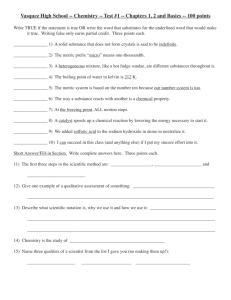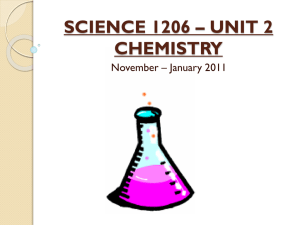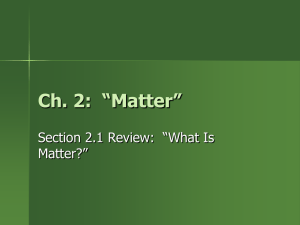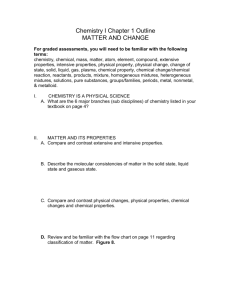what is chemistry?
advertisement
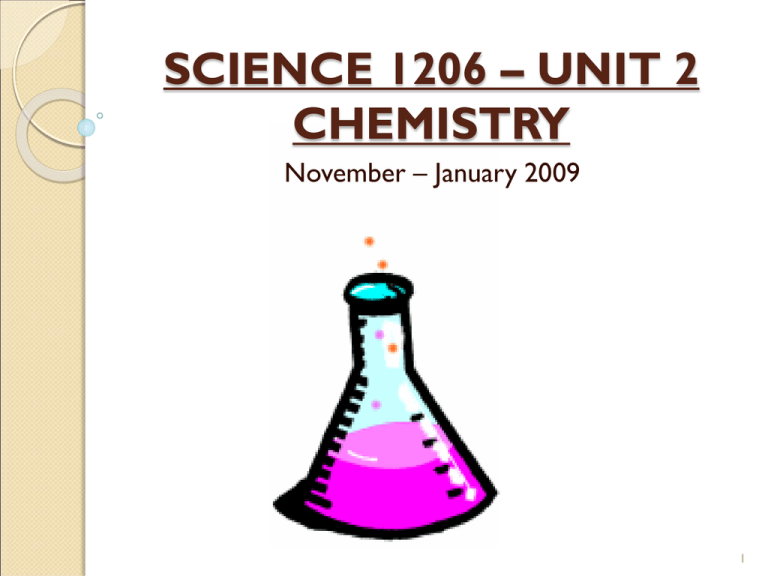
SCIENCE 1206 – UNIT 2 CHEMISTRY November – January 2009 1 UNIT OUTLINE CHEMISTRY TERMINOLOGY ◦ General Terms ◦ Periodic Table BOHR DIAGRAMS ATOMS versus IONS NAMING COMPOUNDS ◦ Ionic ◦ Molecular ◦ Acids CHEMICAL REACTIONS ◦ Balancing Chemical Equations ◦ 5 Reaction Types 2 IMPORTANT TO KNOW . . . PERIODIC TABLE!!! Memorize 48 symbols Chem Facts sheet LINK LINK 2 3 CHEMISTRY TERMS MATTER ◦ Anything that has mass and volume (takes up space). ◦ What is not matter? Energy MASS ◦ The amount of matter an object contains, measured in grams, g. 4 3 STATES OF MATTER SOLID ◦ Definite volume and shape LIQUID ◦ Definite volume, indefinite shape GAS ◦ Indefinite volume, indefinite shape Chemistry Subscripts ◦ ◦ ◦ ◦ (s) - solid (l) - liquid (g) - gas (aq) – aqueous, dissolved in water 5 3 STATES OF MATTER 6 WHAT IS CHEMISTRY? Chemistry is the study of the properties and chemical changes of matter. So, chemistry matters Examples of chemical reactions: ◦ Rusting ◦ Burning/Combustion ◦ C+ O2 CO2 7 TWO TYPES OF CHEMISTRY PURE CHEMISTRY ◦ Theoretical work that involves DESCRIBING known substances and DISCOVERING new compounds. APPLIED CHEMISTRY ◦ Practical work that involves searching for USES for known substances. 8 PHYSICAL PROPERTY A QUALITY or CHARACTERISTIC of a substance that can be observed WITHOUT a chemical reaction. Examples of Physical Properties ◦ ◦ ◦ ◦ ◦ ◦ ◦ ◦ ◦ ◦ State of matter Hardness Colour Malleability Ductility Odor Solubility Brittleness Conductivity Melting Point and Boiling Point 9 PHYSICAL CHANGE A change in state of matter. ◦ ◦ ◦ ◦ ◦ ◦ Melting/fusion – SOLID to LIQUID Freezing – LIQUID to SOLID Evaporation – LIQUID to GAS Condensation – GAS to LIQUID Sublimation – SOLID to GAS Deposition – GAS to SOLID Ex: H2O(s) H2O(l) 10 CHEMICAL PROPERTY A BEHAVIOUR that can only be observed during a CHEMICAL CHANGE. eg. magnesium ribbon burning 2 Mg(s) + O2 2 MgO(s) + light energy CHEMICAL CHANGE A change that forms ONE OR MORE NEW SUBSTANCES. eg. Iron Rusting 4 Fe(s) + 3 O2(g) Fe2O3(s) 11 5 INDICATORS OF CHEMICAL CHANGE DIFFICULT TO REVERSE. Observe the next 4… 12 CHEMICAL CHANGE INDICATORS COLOUR CHANGE 13 CHEMICAL CHANGE INDICATORS BUBBLES OF GAS 14 CHEMICAL CHANGE INDICATORS SOLID (PRECIPITATE) FORMATION 15 CHEMICAL CHANGE INDICATORS HEAT/LIGHT GIVEN OFF 16 HOMEWORK!!! Identify the following as a PHYSICAL PROPERTY or a CHEMICAL PROPERTY. 1. 1. 2. 3. 4. 5. Burns in air when heated. Melts at 98 degrees Celsius. Reacts violently with water. Can be cut with a knife. Conducts electricity. Identify the following as a PHYSICAL CHANGE or a CHEMICAL CHANGE. 2. 1. 2. 3. 4. Digesting a meal. Butter melting in a pan. Burning gasoline. Wood rotting. LINK 17 MATTER FLOW CHART-Draw MATTER PURE SUBSTANCE COMPOUND MIXTURE HOMOGENEOUS MIXTURE (SOLUTION) HETEROGENEOUS MIXTURE ELEMENT ATOM 18 PURE SUBSTANCE Made up of only ONE TYPE OF ATOM or ATOM COMBINATION Stays the same in response to a physical change Example: ◦ O2 ◦ H 2O TWO TYPES: ◦ Element ◦ Compound 19 TYPES OF PURE SUBSTANCES ELEMENT ◦ A pure substance that CANNOT be broken down into a simpler substance by a CHEMICAL CHANGE. ◦ It is made up of 1 TYPE OF ATOM. Element SYMBOLS - first letter UPPERCASE and the second letter lowercase Element names - written in lowercase letters. ◦ Examples: Na – sodium Ar – argon Li – lithium W - tungsten 20 TYPES OF PURE SUBSTANCES COMPOUND ◦ A pure substance that CAN be broken down into its elements with a CHEMICAL CHANGE. ◦ made from two or more elements are chemically bonded in fixed ratios. ◦ Examples: NaCl – sodium chloride C6H12O6 – glucose CH4 – methane H2O - water 21 MIXTURE Contains 2 or more pure substances HOMOGENEOUS MIXTURE AKA SOLUTION only one visible phase eg. air, apple juice, salt water HETEROGENEOUS MIXTURE Contains 2 or more visible phases throughout eg. Soil, soup, fruitcake 22 DIATOMIC MOLECULES There are 7 elements that are diatomic, or found in pairs, in their natural state. These are: ◦ ◦ ◦ ◦ ◦ ◦ ◦ ◦ H2 O2 F2 Br2 I2 N2 Cl2 Also P4 and S8 Memory tool: P.S., HOFBrINCl 23 REACTANTS ◦ Starting Materials PRODUCTS ◦ New substances formed CHEMICAL REACTION ◦ Reactants Products ◦ Example: ◦ C(s) + O2(g) CO2(g) 24 HOMEWORK . . . 1. Name the type of pure substance that is found on the periodic table. 2. Give an example of each of the following: 1. Pure substance 2. Heterogeneous mixture 3. Homogeneous mixture LINK 25
